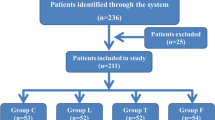Abstract
Purpose
Although attenuation of tube-induced coughing is necessary in specific types of surgery, the best method for such attenuation is still unclear. We studied the combined intervention of endotracheal lidocaine and intravenous remifentanil compared to intravenous remifentanil alone with respect to coughing during emergence from anesthesia.
Methods
We examined 60 ASA 1–2 patients (age, 20–69 years) undergoing tympanoplasty under general anesthesia. Anesthesia was induced with propofol, remifentanil, and rocuronium. The trachea was intubated using a laryngotracheal instillation of topical anaesthetic (LITA) tracheal tube. Anesthesia was maintained with propofol and remifentanil (0.1–0.3 μg/kg/min). Propofol was discontinued and remifentanil (0.1 μg/kg/min) was continued at the end of the operation. Patients were randomly allocated to the lidocaine (n = 30) and control groups (n = 30). We administered 3 ml 4 % lidocaine via the LITA tube to patients in lidocaine group at the end of the operation. The trachea was extubated when the patient regained consciousness and followed orders. Coughing was evaluated using a 4-point scale by an observer who examined the video records at extubation.
Results
Fewer patients in lidocaine group (8 of 30) than in control group (18 of 30, p < 0.01) coughed. Fewer patients in lidocaine group (2 of 30) than in control group (12 of 30, p < 0.01) had moderate or severe cough (scale 2 or 3).
Conclusions
This study is consistent with the finding that endotracheal lidocaine administration and continuous infusion of remifentanil before extubation is useful to prevent coughing on emergence from anesthesia.


Similar content being viewed by others
References
Taheri A, Hajimohamadi F, Soltanghoraee H, Moin A. Complications of using laryngeal mask airway during anaesthesia in patients undergoing major ear surgery. Acta Otorhinolaryngol Ital. 2009;29(3):151–5.
Daley MD, Norman PH, Coveler LA. Tracheal extubation of adult surgical patients while deeply anesthetized: a survey of United States anesthesiologists. J Clin Anesth. 1999;11(6):445–52.
Griffin RM, Hatcher IS. Aspiration pneumonia and the laryngeal mask airway. Anaesthesia. 1990;45(12):1039–40.
Hohlrieder M, Tiefenthaler W, Klaus H, Gabl M, Kavakebi P, Keller C, Benzer A. Effect of total intravenous anaesthesia and balanced anaesthesia on the frequency of coughing during emergence from the anaesthesia. Br J Anaesth. 2007;99(4):587–91.
Nho JS, Lee SY, Kang JM, Kim MC, Choi YK, Shin OY, Kim DS, Kwon MI. Effects of maintaining a remifentanil infusion on the recovery profiles during emergence from anaesthesia and tracheal extubation. Br J Anaesth. 2009;103(6):817–21.
Gonzalez RM, Bjerke RJ, Drobycki T, Stapelfeldt WH, Green JM, Janowitz MJ, Clark M. Prevention of endotracheal tube-induced coughing during emergence from general anesthesia. Anesth Analg. 1994;79(4):792–5.
Minogue SC, Ralph J, Lampa MJ. Laryngotracheal topicalization with lidocaine before intubation decreases the incidence of coughing on emergence from general anesthesia. Anesth Analg. 2004;99(4):1253–7.
Steinhaus JE, Gaskin L. A study of intravenous lidocaine as a suppressant of cough reflex. Anesthesiology. 1963;24:285–90.
Smith FR, Kundahl PC. Intravenously administered lidocaine as cough depressant during general anesthesia for bronchography. Chest. 1973;63(3):427–9.
Yukioka H, Yoshimoto N, Nishimura K, Fujimori M. Intravenous lidocaine as a suppressant of coughing during tracheal intubation. Anesth Analg. 1985;64(12):1189–92.
Soltani HA, Aghadavoudi O. The effect of different lidocaine application methods on postoperative cough and sore throat. J Clin Anesth. 2002;14(1):15–8.
Huang CJ, Tsai MC, Chen CT, Cheng CR, Wu KH, Wei TT. In vitro diffusion of lidocaine across endotracheal tube cuffs. Can J Anaesth. 1999;46(1):82–6.
Okuda M, Furuhashi K, Konishi K, Muneyuki M. Effects of intravenous or endotracheal lidocaine on circulatory changes during recovery from general anesthesia. J Anesth. 1990;4(4):331–6.
Lee JH, Koo BN, Jeong JJ, Kim HS, Lee JR. Differential effects of lidocaine and remifentanil on response to the tracheal tube during emergence from general anaesthesia. Br J Anaesth. 2011;106(3):410–5.
Song JW, Kwak YL, Lee JW, Chang CH, Kim HS, Shim YH. The optimal effect site concentration of remifentanil in combination with intravenous midazolam and topical lidocaine for awake fibreoptic nasotracheal intubation in patients undergoing cervical spine surgery. Minerva Anestesiol. 2012;78(5):521–6.
Lee B, Lee JR, Na S. Targeting smooth emergence: the effect site concentration of remifentanil for preventing cough during emergence during propofol-remifentanil anaesthesia for thyroid surgery. Br J Anaesth. 2009;102(6):775–8.
Olofsen E, Boom M, Nieuwenhuijs D, Sarton E, Teppema L, Aarts L, Dahan A. Modelling the non-steady state respiratory effects of remifentanil in awake and propofol-sedated healthy volunteers. Anesthesiology. 2010;112(6):1382–95.
Himes RS Jr, DiFazio CA, Burney RG. Effects of lidocaine on the anesthetic requirements for nitrous oxide and halothane. Anesthesiology. 1977;47(5):437–40.
Diachun CA, Tunink BP, Brock-Utne JG. Suppression of cough during emergence from general anesthesia: laryngotracheal lidocaine through a modified endotracheal tube. J Clin Anesth. 2001;13(6):447–51.
Andrzejowski J, Francis G. The efficacy of lidocaine administered via the LITA tracheal tube in attenuating the extubation response in beta-blocked patients following craniotomy. Anaesthesia. 2002;57(4):399–401.
Conflict of interest
None.
Author information
Authors and Affiliations
Corresponding author
About this article
Cite this article
Yamasaki, H., Takahashi, K., Yamamoto, S. et al. Efficacy of endotracheal lidocaine administration with continuous infusion of remifentanil for attenuating tube-induced coughing during emergence from total intravenous anesthesia. J Anesth 27, 822–826 (2013). https://doi.org/10.1007/s00540-013-1627-3
Received:
Accepted:
Published:
Issue Date:
DOI: https://doi.org/10.1007/s00540-013-1627-3




